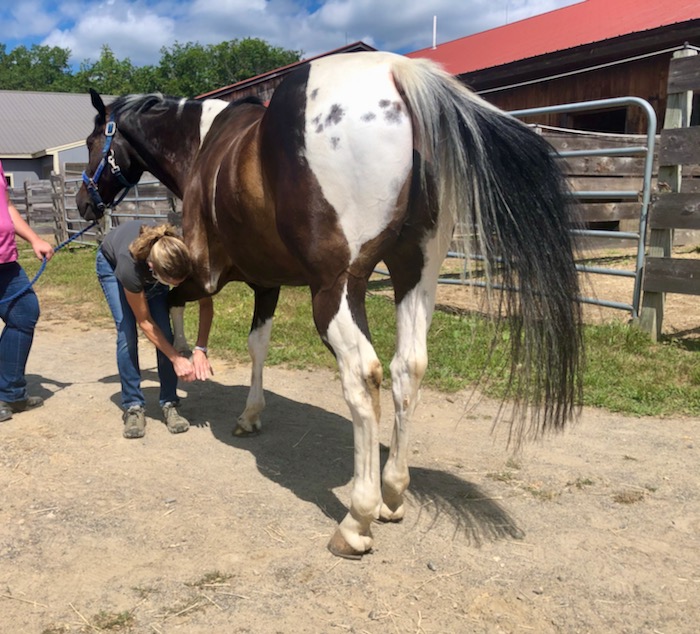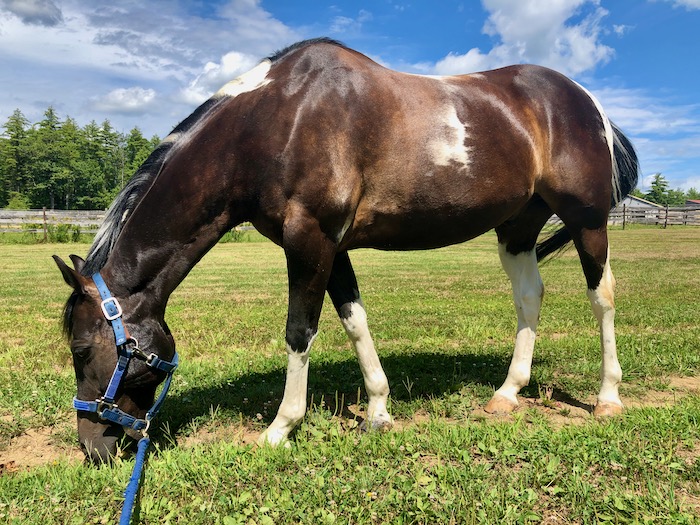In my warmup before last Thursday’s jumping lesson, Tonka was off. Not so obvious on the straightaways, but definitely on the corners.
Determining exactly where the lameness is originating from can be tricky, but this seemed to be a left front issue. In the weeks prior to this, Tonka had occasionally started out stiffly or taken a few uneven steps, but had always worked out of it. Even now, when he was clearly lame, he didn’t seem stressed. It wasn’t an emergency, but it was time for the veterinarian to take a look.
She came out on Monday. First she did a lameness exam.

The lameness did originate in his left front. His leg was clean, cool and not at all ouchy. The likely culprit was in the hoof.
A horse’s hoof is an extremely complicated piece of anatomy with multiple bones, joints, ligaments, blood supply and laminae.

From “A handbook of horse-shoeing : with introductory chapters on the anatomy and physiology of the horse’s foot” by Jno. A. W. Dollar, 1898. Scan available https://doi.org/10.5962/bhl.title.29351
Tonka didn’t have a throbbing pulse, his hoof was the right temperature and there were no obvious external injuries. All good. It indicated that perhaps the issue was arthritis. Or simply soreness. We’re in a drought. The ground, even in the grass paddocks, is rock hard. Add to that the jumping we’ve done, and perhaps Tonka’s joints were achy. Tonka is shod with pads and cushions (he’s always had thin soles) but even that protective shoeing hasn’t been enough to stave off soreness.

To isolate what part of the hoof was causing him to limp, the bulb of his heel was injected with a drug similar to novocaine. That didn’t mask his lameness. Which was good. Bulb lameness is difficult to remedy. Next the entire hoof was injected, and Tonka trotted out soundly. This pointed to the coffin joint (previously called the pedal bone) as the culprit. I asked for x-rays to be taken. I like to have a baseline for future reference, and I also wanted to see if there were serious changes happening inside of Tonka’s hoof. His joints and angles looked fine! Other than the thin soles, Tonka has always had nice big, symmetrical, sturdy, healthy hoofs.

We just had to give what was inside of them a little help. The veterinarian injected both coffin joints with a cocktail of drugs that should add fluids, alleviate inflammation and restore health to the hoof.
For the first 3 days after injection, Tonka has been kept quiet in his stall and run-out pen. I’ve been hand-grazing to keep both of us happy (I need my horse time!)

I can get back in the saddle this Friday for a walk, and then, depending on how Tonka is feeling, ease him back into work. Full effect of the injections should be seen in 10 to 14 days. This means I probably will miss the last horse show of the summer, but that’s okay. I’ve been checking out some new trails. Although the drought has been a disaster for farmers, and hard on our horse’s hoofs, it’s opened up some trails that had been too wet for me to access. The other day I hiked out to this. I’ll take Tonka to explore there next week – if he tells me he’s up to it.
(Even in this pretty video, you can see how the ground looks like concrete.)
Have you had your horse’s coffin joints injected? Tell me how that went in the comments!


I’ve had many injections on past horses, but none in the coffin bone. Hope this cures what ails Tonka. I’ll be watching and thinking healing thoughts for him.
Thanks!
Hi Terry, I will be interested to see how your horse responds to this injection and what the injection consisted of. My horse just recently came up lame, left front, determined by vet to be in the hoof, but no heat so we tried a steroid injection into the coffin bone area. We hope to see positive results within 5 days. We did not do an X-ray but will if the injection does not prove successful.
My vet injected: Hyvisc, vetalog, amikacin. Yours?
Gee, I hope Tonka gets better and this doesn’t affect his jumping. He likes it so much, and so do you.
He’s already going sounder 🙂
Amen!
11/12/20:
My horse’s front coffin joints were injected two days ago (Tuesday). I’ve only been hand walking her with no turnout. I’ll be testing her out slowly on Saturday. I was delighted to come across your article. Seems like you and my vet are on the same page 🙂
You’ve given me some encouragement, Terry!
This is the first time that any injections that I’ve had done for Tonka have showed a dramatic improvement. I think it helped that I caught it early. Also that x-rays don’t show any bony changes. I hope your horse’s situation is similar and you have the same results.
If lameness reappears have you or your vet considered Adequan injections? https://adequan.com/Horse-Owner-FAQs
They are a series of intramuscular injections given every 4 days over a month that the owner can administer. It causes more synovial fluid to be produced and has anti inflamaory and healing influences on the cartilage. The effects can last 6 months to a year or may be premanent. Many horses get aqequan for ‘ maintanence’.It does not mask pain, it treats the cause of the pain.
Adequan can be a game-changer. I wish I could use it for my own joints! It doesn’t address everything, though. I had Tonka on it for a couple of years. There was no discernible improvement so he’s no longer getting it. My vet agrees that at this point other treatments are more effective.
Adequan is used in horses and dogs. Surely if it worked for artritic people it would be approved for human use.Why was Tonka on it for several years? I tried a course of it on my short stepping club footed horse and it did not do much. In fact he was worse. But the shoer had shod him with a 2% wedge pad and changed the angles too fast. What that did do however was rule out navicular because the wedge took the pressure off the DDFTendon. What made my horse instantly sound was a new shoer who trimmed each hoof angle as it needed to be and put on an Equilibrium shoe. He trotted out sound, first time in months and my trainer and I both cried.
Mine had a mystery lameness come up almost overnight. Came in limping and there was no evidence of injury, so I assumed it was an abscess brewing and started treating it as such (even though there was no heat or strong pulse in the hoof). When it was clear nothing was coming of it, I had the farrier check again and he couldn’t find anything either.
Took him to rood and riddle (they aren’t far from me) and he got X-rays. Navicular bone looked good, but he clearly has some heel pain so they began conservatively with shoes and bute. When that wasn’t helping they injected his coffin bones along with changing the shoes to I think he said a rail shoe to help take some of the force off the joints. I’d have to see what they used in the injections as I can’t remember. That was just done 3 weeks ago but he’s still off so I hope that doesn’t mean they failed. 🙁 I’m calling the vet back Monday to see what they think. I’ve never had to give any horses injections before so I’m totally new to all this.
It’s frustrating, isn’t it? It’s a process of elimination instead of directly seeing the cause. Tonka still isn’t 100 percent sound, but he works out of it. It’s a judgement call – I don’t believe in pushing through pain, but what if the riding helps get the kinks out?
Did your horse come right? My mare was injected over 5 weeks ago and still slightly lame
Injections worked for helping with maintenance of small amounts of arthritis. Unfortunately, Tonka had a catastrophic fail of the joint between P2 and P3 and is now retired. He’s happily living in a field by day and a deeply bedded stall at night.
Did the P2/P3 joint issue turn out to be the root of the original problem?
Yes. Unfortunately, despite attempts at various therapies, that joint continues to degrade. An x-ray image shows essentially no joint capsule left. We have no idea why this has occurred in this one spot. The rest of Tonka is quite healthy. He is in full retirement in a grassy field – the springy sod keeps him happy, albeit too lame for anything other than grazing.
I am looking for a remedy for an old post laminitic horse i just don’t seem to get comfortable. What was the cocktail injection made up of that tonka received ?
Laminitis is such a challenging issue to come back from. I don’t know if Tonka’s situation is anything like your horse’s, as he doesn’t have the changes in his hoof that occur in a horse who’s had laminitis. Tonka’s injection was all about increasing the fluid and lubrication in the joint capsule. Your Veterinarian likely has a preferred mixture, and there’s been much progress lately in these drugs so I wouldn’t want to recommend anything.